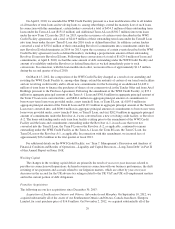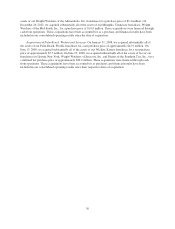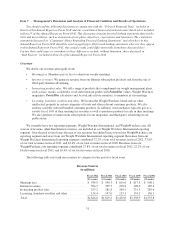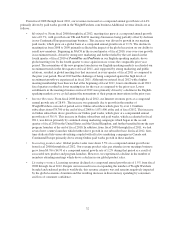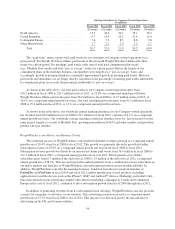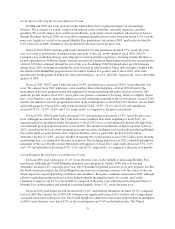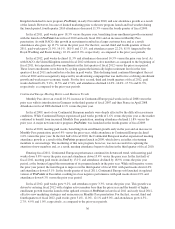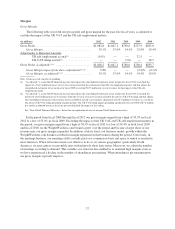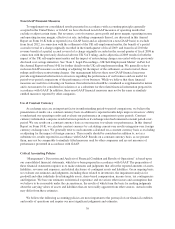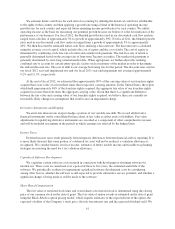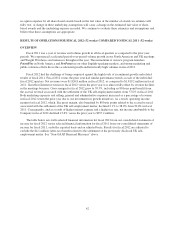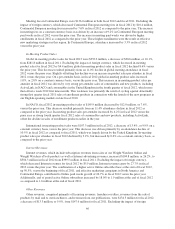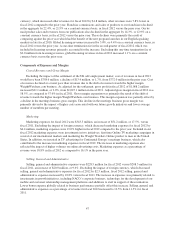WeightWatchers 2012 Annual Report Download - page 55
Download and view the complete annual report
Please find page 55 of the 2012 WeightWatchers annual report below. You can navigate through the pages in the report by either clicking on the pages listed below, or by using the keyword search tool below to find specific information within the annual report.Non-GAAP Financial Measures
To supplement our consolidated results presented in accordance with accounting principles generally
accepted in the United States, or GAAP, we have disclosed non-GAAP measures of operating results that
exclude or adjust certain items. Net revenues, cost of revenues, gross profit and gross margin, operating income
and operating income margin, effective tax rate, including components thereof, are discussed in this Annual
Report on Form 10-K both as reported (on a GAAP basis) and as adjusted (on a non-GAAP basis) to exclude
from fiscal 2012, in connection with the settlement of the UK self-employment matter, the benefit of a partial
accrual reversal of a charge originally recorded in the fourth quarter of fiscal 2009, and from fiscal 2010 the
revenue benefit of a partial accrual reversal of a charge originally recorded in the second quarter of fiscal 2008 in
connection with the previously disclosed adverse UK VAT ruling; and to adjust fiscal 2009 results for both the
impact of the UK self-employment matter and the impact of restructuring charges associated with our previously
disclosed cost savings initiatives. See “Item 3. Legal Proceedings—UK Self-Employment Matter” in Part I of
this Annual Report on Form 10-K for further details on the UK self-employment ruling. We generally refer to
such non-GAAP measures as excluding or adjusting for the impact of the settlement, accrual reversal, these
rulings and/or these restructuring charges. Our management believes these non-GAAP financial measures
provide supplemental information to investors regarding the performance of our business and are useful for
period-over-period comparisons of the performance of our business. While we believe that these financial
measures are useful in evaluating our business, this information should be considered as supplemental in nature
and is not meant to be considered in isolation or as a substitute for the related financial information prepared in
accordance with GAAP. In addition, these non-GAAP financial measures may not be the same as similarly
entitled measures reported by other companies.
Use of Constant Currency
As exchange rates are an important factor in understanding period-to-period comparisons, we believe the
presentation of results on a constant currency basis in addition to reported results helps improve investors’ ability
to understand our operating results and evaluate our performance in comparison to prior periods. Constant
currency information compares results between periods as if exchange rates had remained constant period-over-
period. We use results on a constant currency basis as one measure to evaluate our performance. In this Annual
Report on Form 10-K, we calculate constant currency by calculating current-year results using prior-year foreign
currency exchange rates. We generally refer to such amounts calculated on a constant currency basis as excluding
or adjusting for the impact of foreign currency. These results should be considered in addition to, not as a
substitute for, results reported in accordance with GAAP. Results on a constant currency basis, as we present
them, may not be comparable to similarly titled measures used by other companies and are not measures of
performance presented in accordance with GAAP.
Critical Accounting Policies
“Management’s Discussion and Analysis of Financial Condition and Results of Operations” is based upon
our consolidated financial statements, which have been prepared in accordance with GAAP. The preparation of
these financial statements requires us to make estimates and judgments that affect the reported amounts of assets,
liabilities, revenues and expenses, and related disclosure of contingent assets and liabilities. On an ongoing basis,
we evaluate our estimates and judgments, including those related to inventories, the impairment analysis for
goodwill and other indefinite-lived intangible assets, share-based compensation, income taxes, tax contingencies
and litigation. We base our estimates on historical experience and on various other factors and assumptions that
we believe to be reasonable under the circumstances, the results of which form the basis for making judgments
about the carrying values of assets and liabilities that are not readily apparent from other sources. Actual results
may differ from these estimates.
We believe the following accounting policies are most important to the portrayal of our financial condition
and results of operations and require our most significant judgments and estimates.
39


